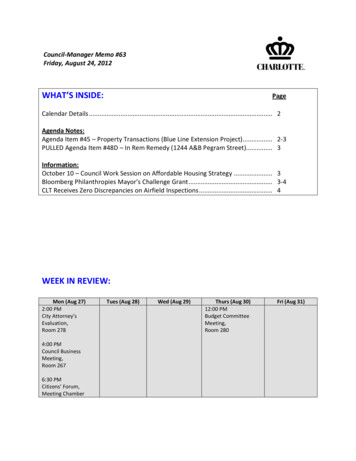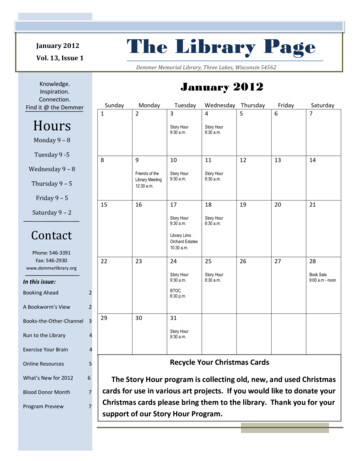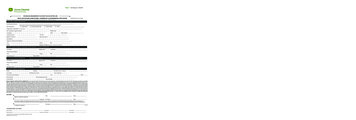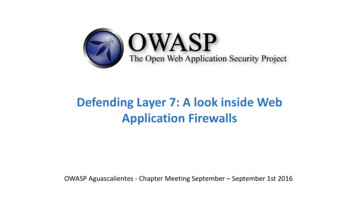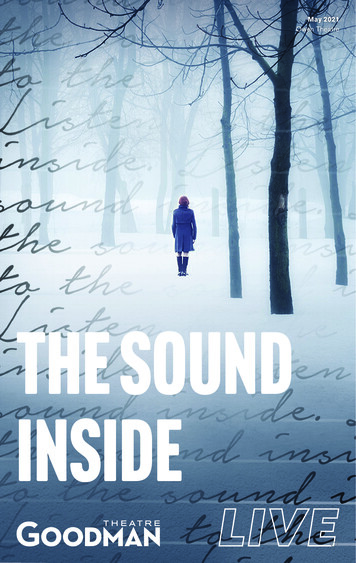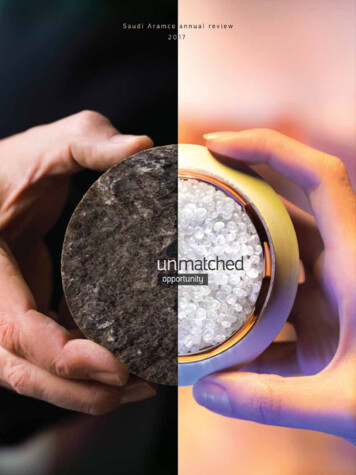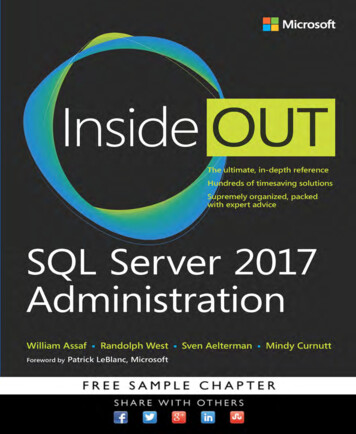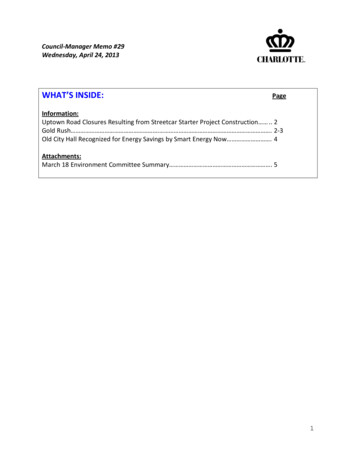
Transcription
Council-Manager Memo #29Wednesday, April 24, 2013WHAT’S INSIDE:PageInformation:Uptown Road Closures Resulting from Streetcar Starter Project Construction . 2Gold Rush . . 2-3Old City Hall Recognized for Energy Savings by Smart Energy Now . 4Attachments:March 18 Environment Committee Summary . 51
INFORMATION:Uptown Road Closures Resulting from Streetcar Starter Project ConstructionStaff Resource: Tonia Wimberly, Engineering & Property Management, 704-353-1931,twimberly@charlottenc.govPlanned road closures in the uptown area will occur for the next several weeks as constructioncontinues on the Streetcar Starter Project. Staff within multiple departments have beenworking closely to ensure the closures are communicated to the traveling public as well as areabusinesses. The latest closures and detours are listed below and were shared with Streetcarstakeholders, email notification subscribers, and employees in the government district.A detour map and more information on the project can be found on the Charlotte Streetcarwebsite. Road Closure for East Trade Street/Elizabeth Avenue and McDowell StreetDuration: April 19 – April 29, 2013Intersection of East Trade Street/Elizabeth Avenue and McDowell Street will remainclosed through Monday, April 29, 2013. Motorists on Trade Street/Elizabeth Avenue willbe able to travel between Kings Drive and Davidson Street. No turns will be allowed atMcDowell Street from Trade Street/Elizabeth Avenue. Motorists on McDowell Streetmust follow the detours suggested. Road Closure for Trade Street (College – Caldwell)Duration: April 21 – May 19, 2013A road closure is planned for Trade Street from Caldwell Street to College Street fromApril 21 through May 19, 2013 in order to install water lines, storm drain lines, andother utility work associated with the Streetcar Starter Project. Westbound Trade Streettraffic will be routed to 4th Street via Caldwell and College Streets. Eastbound TradeStreet traffic will be routed to 5th Street via College and Caldwell Streets.Gold RushStaff Resource: Ruffin Hall, City Manager’s Office, 704-336-3403, rlhall@charlottenc.govDue to a scheduling issue, the Council did not receive the dinner briefing on the Gold Rush at itsmeeting on April 22. The Gold Rush is a free circulator service operated by CATS in UptownCharlotte during the hours of 7:00 a.m. and 6:00 p.m. The Red Line runs along Trade Streetbetween Johnson C Smith University (JCSU) and Presbyterian Hospital. Students from JCSU,Central Piedmont Community College and Johnson and Wales University as well as Center Cityemployees take advantage of the service which connects to the Lynx Blue Line and theCharlotte Transportation Center. The Orange Line runs along Tryon Street, from Morehead to10th Street.2
Approximately one million riders use the Gold Rush service each year. In fiscal year 2013 it willcost just over 1.5 million to operate the service. Funding for the service comes from CATS,state transit dollars, and federal grants, as well as corporate contributions collected byCharlotte Center City Partners (CCCP).FY14 FundingTwo federal grants which help support the Gold Rush are expiring in June. Because of the lossof these grants and a decline in private contributions, the operating budget for the Gold Rushfor FY14 is less than half the operating budget for FY13. As a result, the City and CCCP areproposing that operations on the Red Line continue, but that the Orange Line be temporarilysuspended for FY14. Public outreach to communicate this potential change includes: An initial public meeting was held in February to communicate CATS service changes,including possible reductions in Gold Rush Services.The Metropolitan Transit Commission will be briefed on the Gold Rush at its meeting onWednesday, April 24, 2013.A second public meeting is scheduled on May 8, 2013 in room CH-14 at the GovernmentCenter from 11:30-1:30.The Metropolitan Transit Commission will make a determination about the FY14 GoldRush service levels following the second public meeting.FY15 FundingIn December, the City and CCCP hired Nelson/Nygaard, a transit and multi-modaltransportation planning consultant to evaluate the Gold Rush. The scope of their study is toevaluate the operations, routes and funding of the Gold Rush for its future operations, giventhe loss of federal grants and the decline in private donations. Initial findings of the studyindicate: Both routes are productive and effective, above the industry standard for transitservice.The Red Line carries over twice the riders of the Orange Line (Red: 650,000 riders;Orange: 300,000 riders).The Gold Rush serves the components of a successful transit market: employmentcenter, activity centers, neighborhoods, and transit connections.The City and CCCP will continue to work with the consultant to determine a strategy for FY15and beyond.Click here to view the 4/22 Gold Rush Dinner Briefing Presentation3
Old City Hall Recognized for Energy Savings by Smart Energy NowStaff Resources: Laurie Sickles, Engineering & Property Management, 704-336-4811,lsickles@charlottenc.govDavid Miller, Engineering &Property Management, 704-336-2250, dmiller@charlottenc.govJeff Furr, Engineering &Property Management, 704-336-7046, wfurr@charlottenc.govOn April 23, 2013, the Smart Energy Now program, as part of their Building RecognitionProgram, recognized Old City Hall as one of the top two energy saving buildings in the category“buildings under 100,000 square feet.” Smart Energy Now is one of the four pillars of EnvisionCharlotte.In 2009, Building Services identified Old City Hall as an excellent candidate to undergo energyefficiency based renovations. During 2010-2011, mechanical and lighting upgrades were thefocus of an Energy Efficiency & Conservation Block Grant funded renovation project. Thisproject included the replacement of air terminal boxes, upgrading the building’s controlsystems, and the replacement/retrofit of interior lighting. Recognizing the historical significanceof the building, staff worked diligently to preserve historical features while making the buildingmore energy efficient.Old City Hall achieved an energy use reduction of 43% according to E&PM’s baseline year of2009. Energy use intensity (EUI) is the benchmark metric used to analyze energy consumptionat City facilities. EUI is the energy consumption (electric and gas) divided by the square footageof a facility. The EUI graph of Old City Hall depicts the EUI of 116.3 (2009) and a current EUI of66.1 (2013), which represents an energy reduction of 43%. Additionally, the energy efficiencyrenovation project and dedicated efforts of staff ensuring energy efficient management of OldCity Hall has resulted in accumulated avoided costs of 47,000. Accumulative avoided costsrepresent the raw dollar energy savings, which requires economic analysis over a period oftime. In the case of Old City Hall, future energy costs were ‘avoided’ by implementation of alarge scale renovation project and combined energy efficient practices.4
ATTACHMENTS:March 18 Environment Committee SummaryClick here to view the March 18 Environment Committee Summary5
between Johnson C Smith University (JCSU) and Presbyterian Hospital. Students from JCSU, Central Piedmont Community College and Johnson and Wales University as well as Center City . The Metropolitan Transit Commission will be briefed on the Gold Rush at
